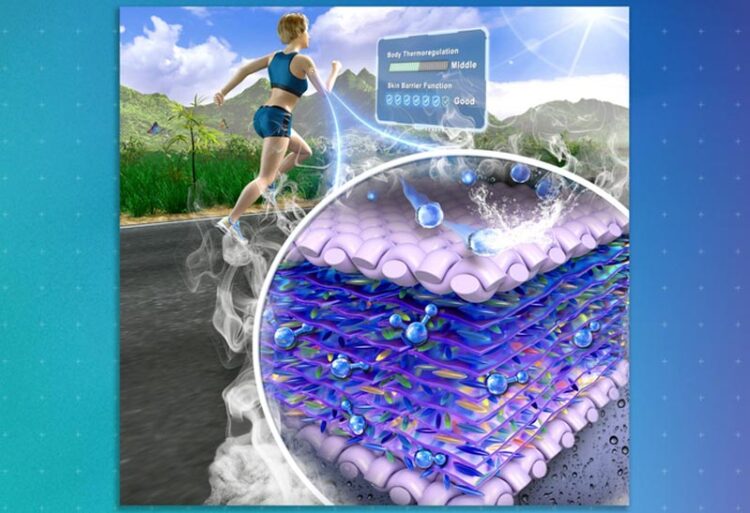Superhydrophobic biosensor could measure sweat vapors on the body

A biosensor developed by Huanyu “Larry” Cheng, the James L. Henderson, Jr. Memorial Associate Professor of Engineering Science and Mechanics, features superhydrophobic material that measures sweat vapor without absorbing water.
Credit: Provided by Larry Cheng/Penn State
Sweat contains biomarkers that help doctors make health diagnoses. Wearable sensors can be used to monitor a person’s perspiration rate and provide information about the skin, nervous system activity and underlying health conditions. But not all sweat is created equal, and some cannot be measured with current sensors. A newly developed superhydrophobic biosensor could be used as a diagnostic tool to detect such types of sweat.
The sensor, developed by Huanyu “Larry” Cheng, James L. Henderson, Jr. Memorial Associate Professor of Engineering Science and Mechanics, was featured in a paper published in ACS Nano.
Sensible, or liquid, perspiration is sweat that can be perceived by a person, such as during intensive exercise. Wearable sensors can provide continuous, non-invasive tracking of this type of sweat. Insensible, or vapor, perspiration is different. It is the loss of only water from the skin, secreted at a much smaller rate during low-intensity exercise or rest, and measuring it is difficult, according to Cheng.
“Monitoring insensible sweat is of high interest for evaluating skin health and disease conditions, such as eczema and wound healing, as well as underlying health statuses, such as pain or anxiety,” Cheng said. “Skin-interfaced devices that detect sweat rate and loss are currently limited to working with sensible sweat and are not suitable for insensible sweat in a vapor state.”
Cheng developed a prototype of a superhydrophobic sweat sensor to measure vapor from insensible perspiration. The material — a superabsorbent hydrogel composite on a porous substrate sandwiched between two superhydrophobic textile layers — allows the permeation of sweat vapor while preventing the sensor from being affected by the external water droplets of sensible perspiration. The sensor could be integrated with a flexible wireless communication and powering module that continuously monitors sweat rates at different body locations.
“Proof-of-concept demonstrations on human subjects showcased the feasibility to continuously evaluate the body’s thermoregulation and skin barrier functions,” Cheng said. “This enables the assessment of thermal comfort, disease conditions and nervous system activity and provides a low-cost device platform to detect other health-relevant biomarkers in the sweat vapor as the next-generation sweat sensor for smart healthcare and personalized medicine.”
Cheng’s work was supported in part by the National Institutes of Health, the National Science Foundation and Penn State. The National Natural Science Foundation of China, the Natural Science Foundation of Hunan Province and the Furong Scholars of Hunan Province program also provided support.
Co-authors include Shangda Chen, Xiaofeng Li, Yujing Li, Weiyi Liu, Yangchengyi Liu, Shun Qian, Yi Sun, Yao Tian, Peihe Wang, Xiufeng Wang, Fengzhen Yang, Hanlin Yang and Ping Zhang, all affiliated with Xiangtan University in China.
Journal: ACS Nano
DOI: 10.1021/acsnano.2c11267
Method of Research: Experimental study
Subject of Research: People
Article Title: Skin-interfaced superhydrophobic insensible sweat sensors for evaluating body thermoregulation and skin barrier functions
Article Publication Date: 6-Feb-2023
Media Contact
Adrienne Berard
Penn State
akb6884@psu.edu
Original Source
All latest news from the category: Medical Engineering
The development of medical equipment, products and technical procedures is characterized by high research and development costs in a variety of fields related to the study of human medicine.
innovations-report provides informative and stimulating reports and articles on topics ranging from imaging processes, cell and tissue techniques, optical techniques, implants, orthopedic aids, clinical and medical office equipment, dialysis systems and x-ray/radiation monitoring devices to endoscopy, ultrasound, surgical techniques, and dental materials.
Newest articles

Hyperspectral imaging lidar system achieves remote plastic identification
New technology could remotely identify various types of plastics, offering a valuable tool for future monitoring and analysis of oceanic plastic pollution. Researchers have developed a new hyperspectral Raman imaging…

SwRI awarded $26 million to develop NOAA magnetometers
SW-MAG data will help NOAA predict, mitigate the effects of space weather. NASA and the National Oceanic and Atmospheric Administration (NOAA) recently awarded Southwest Research Institute a $26 million contract…

Protein that helps cancer cells dodge CAR T cell therapy
Discovery could lead to new treatments for blood cancer patients currently facing limited options. Scientists at City of Hope®, one of the largest and most advanced cancer research and treatment…



